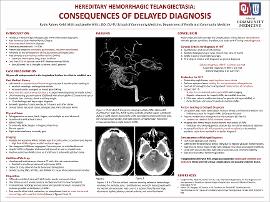| dc.description.abstract | INTRODUCTION: Hereditary Hemorrhagic Telangiectasia (HHT), a rare autosomal dominant disorder also known as Osler-Weber-Rendu Disease, is often underdiagnosed. The initial symptom tends to be spontaneous and recurrent nose bleeds followed by the development of telangiectasias at multiple mucocutaneous locations. In HHT, patients develop arteriovenous malformations (AVMs) in the spine, lung, brain, and liver. This case examines the impact of delayed diagnosis of HHT.
CASE DESCRIPTION: A 36-year-old male with history of alcoholic liver cirrhosis and neurologic deficits due to intraparenchymal hemorrhage (7 months prior) presented to the longitudinal free clinic to establish care and refill seizure medication. On further evaluation, the patient had history of an upper gastrointestinal bleed of unknown etiology in 2013, recurrent spontaneous epistaxis since middle school, telangiectasias on skin and roof of mouth, jaundice, and scleral icterus. Hemoglobin was decreased, but in proportion to his nosebleeds. CT angiogram two months prior showed cerebral AVMs. The diagnosis of HHT was confirmed with three of the four Curacao Criteria. Further evaluation was needed to assess for disease complications including gastrointestinal bleeding and pulmonary and hepatic AVMs. Transthoracic contrast echo with agitated saline, a screen for pulmonary AVMs, was positive. Abdominal ultrasounds showed an AVM in the left lobe of the liver. Due to a continual decrease in hemoglobin, an upper gastrointestinal study was ordered. Interventional radiology and neurovascular specialist were needed to evaluate possible embolizations of AVMs. Care would ideally be managed at a HHT center but due to the uninsured status of the patient this was challenging. Patient is currently stable and has not developed any new symptoms since establishing care.
DISCUSSION: Many physicians who manage the complications of this disease are unfamiliar with the genetic condition; therefore, this disorder is often under-diagnosed. Diagnosis is made when three of four Curacao Criteria are met. The criteria are spontaneous and recurrent epistaxis, mucocutaneous telangiectasia, a first-degree relative with diagnosis, and multi-organ AVMs. An earlier diagnosis could have been made if his previous physicians were more aware of the disease, its associated signs and complications, and had conducted a more thorough history and physical exam. Unfortunately, the diagnosis of HHT was made months after the patient experienced a life-threatening hemorrhagic stroke caused by a cerebral AVM, resulting in neurologic deficits. Hopefully with the knowledge of his diagnosis, physicians will continually screen and evaluate him to prevent serious complications in the future. | en_US |
